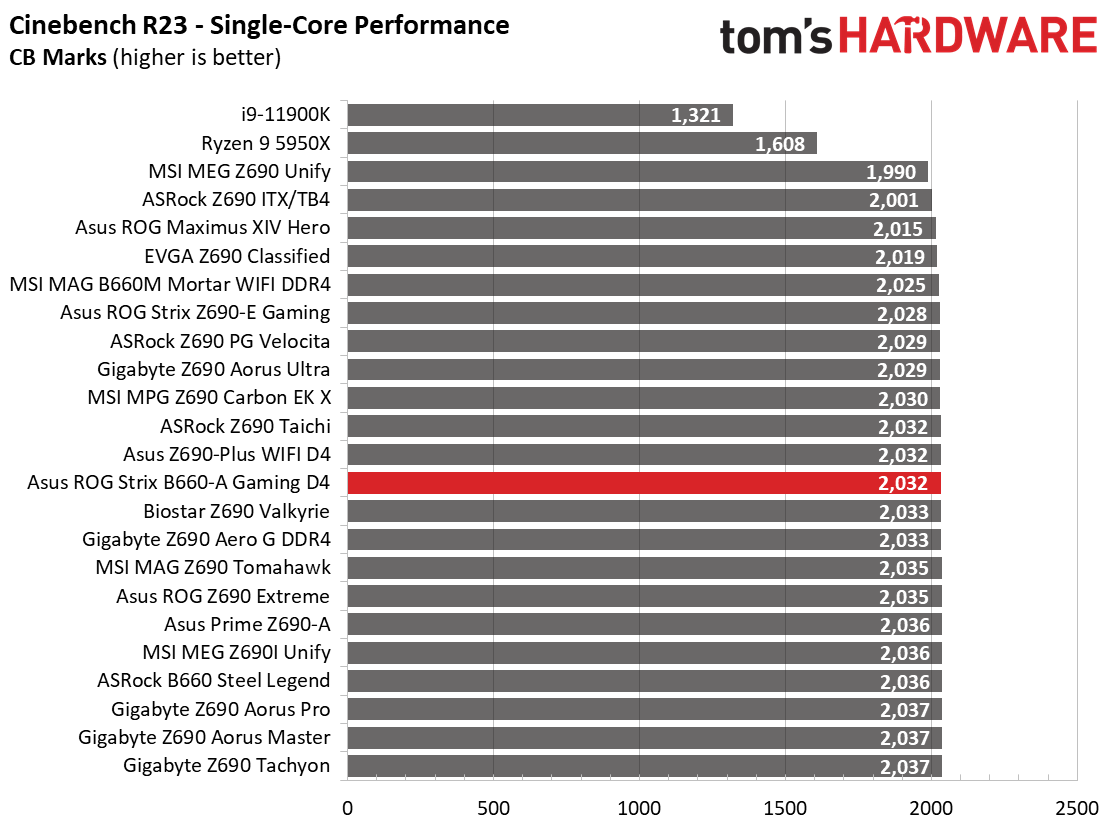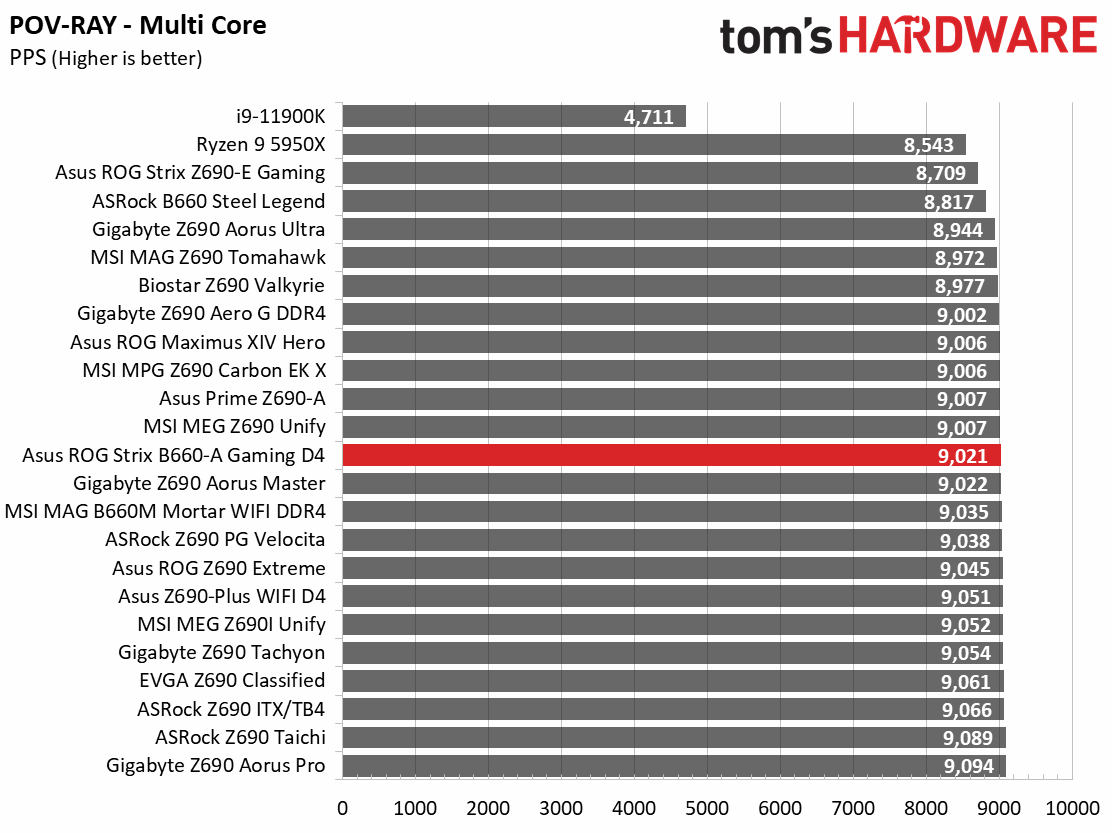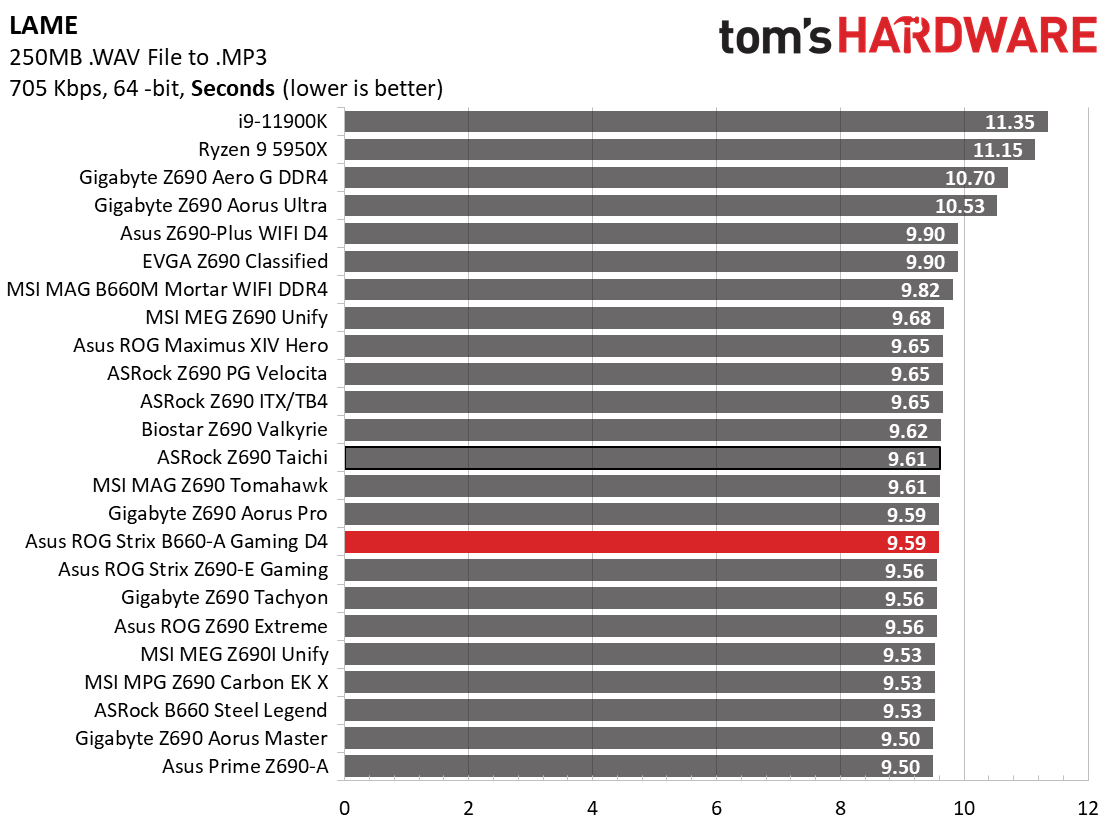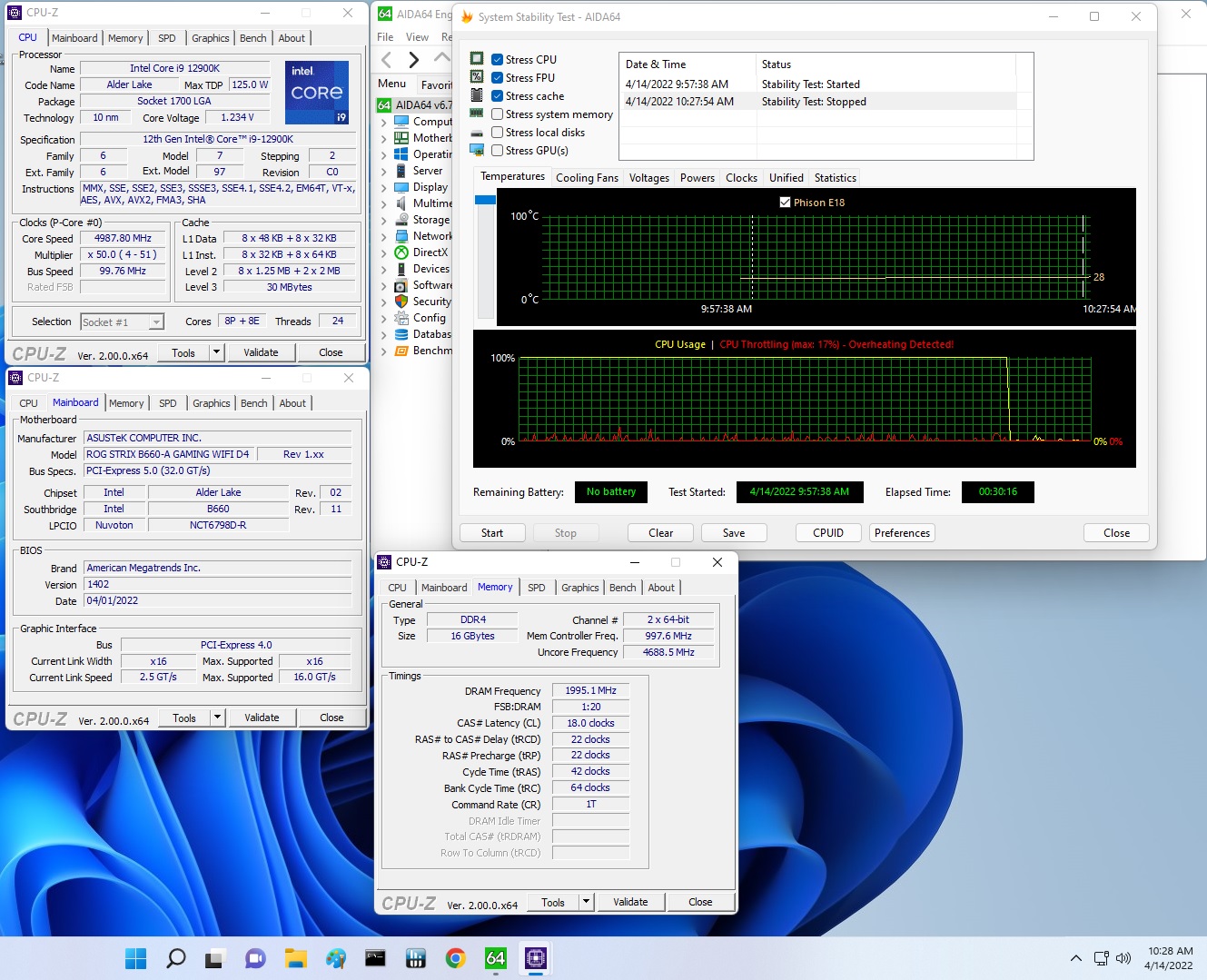Why you can trust Tom's Hardware
Benchmark Results and Final Analysis
Our standard benchmarks and power tests are performed using the CPU’s stock frequencies (including any default boost/turbo) with all power-saving features enabled. We set optimized defaults in the BIOS and the memory by enabling the XMP profile. For this baseline testing, the Windows power scheme is set to Balanced (default), so the PC idles appropriately.
To get the most out of the Intel Alder Lake chips, you need to be on Windows 11 with its updated scheduler. In most cases, Windows 10 performs well. However, some tests (Cinebench R20, Corona and POVRay) take a significant hit. In short, if you’re going with Alder Lake, you must upgrade to Windows 11 for the best results across the board. That may change with patching and updates in the future, though.
Synthetic Benchmarks
Synthetics provide a great way to determine how a board runs, as identical settings should produce similar performance results. Turbo boost wattage and advanced memory timings are places where motherboard makers can still optimize for either stability or performance, though, and those settings can impact some testing.

















The B660-A Gaming showed inconsistent results in our synthetic benchmarks. Some results were above average, such as Procyon Office, while others were around what we expect for this class of board. AIDA64 results for our DDR4 were solid, with latency one of the fastest recorded. In short, there’s nothing to worry about performance-wise in this set of tests.
Timed Applications




Starting with LAME testing, the B660-A took 9.59 seconds to complete, which is on the faster side of average. The Corona Ray Tracing benchmark's results matched the fastest time (another DDR4 Asus board), completing the benchmark in 51 seconds. Handbrake results were average overall, with the x264 testing slower than the DDR5 boards but mixing in with DDR4 at 116 seconds. The x265 test was completed in 298 seconds, which is the second-fastest result tested so far. There are no performance issues in the timed applications.
3D Games and 3DMark




Starting with the launch of the Z690 chipset, we’ve updated our game tests. We’ve updated Far Cry: New Dawn to Far Cry 6 and shifted from F1 2020 to F1 2021. We run the games at 1920x1080 resolution using the Ultra preset (details listed above). As the resolution goes up, the CPU tends to have less impact. The goal with these settings is to determine if there are differences in performance at the most commonly used resolution with settings that most people use (or at least strive for). We expect the difference between boards in these tests to be minor, with most falling within the margin of error. We've also added a minimum FPS value, as that can affect your gameplay and immersion experience.
In F1 2021, the B660-A Gaming averaged 165 fps with minimums of 139 fps, one of the faster results overall. Far Cry 6, on the other hand, was in the middle of the pack, averaging 136 fps with 124 fps minimums. Both results here are right around the average.
Get Tom's Hardware's best news and in-depth reviews, straight to your inbox.
In the 3DMark tests, the Asus scored 14,291 on 3DMark Time Spy and 17,021 on Fire Strike Extreme, both average or slightly above average. In short, you have nothing to worry about when gaming on this motherboard.
Power Consumption / VRM Temperatures

We used AIDA64’s System Stability Test with Stress CPU, FPU and Cache enabled for power testing and used the peak power consumption value. The wattage reading comes from the wall via a Kill-A-Watt meter to capture the entire PC, minus the monitor. The only variable that changes is the motherboard; all other parts are the same.
At idle, the B660-A Gaming WIFI D4 used 54W, which places it more on the efficient side of average sipping power. Load power is a completely different story, peaking at a stunning 403W during our testing. Considering the average is somewhere above 300W (depends on the boards/datasets), using 33% more power is quite a bit. You can thank the BIOS (we used version 1402) for this behavior, as the power limits are notably higher than on other boards. Performance would likely be better if Vcore was kept in check and the system didn’t thermally throttle in some tests (it did so instantly on our stress test). While the system worked and performed OK overall, I’d look at adjusting a vCore offset to thwart the high power use.


VRM temperatures on this power-hungry board topped out at 58 degrees Celsius during stock testing. I'm impressed with the result for the amount of power running through these teamed VRMs, as it easily keeps the power bits running well within specification. Since you can't overclock the processor, there's plenty of headroom left before the MOSFETs run out of spec.
Overclocking

Overclocking the CPU isn’t possible on B660-based chipsets, but the platform does allow for memory speed adjustment. With our DDR4-3600 and DDR4-4000 kits, we simply set XMP and off we went without a hitch. Surely there’s some headroom left, but I’d imagine people purchasing a budget-class board aren’t looking to buy expensive RAM that’s far outside the sweet spot (DDR4 3600-4000).
Bottom Line
After building in and testing the B660-A Gaming WIFI D4, we found it performed well across our various tests. The good news is that judging by the positive results on our performance testing, the throttling we observed only seems to happen when stress testing. Still, the increased power consumption is due to the 280W/330W short/long term turbo parameters in the current (v1402) BIOS. That aside, the Strix board handled our flagship-class Intel i9-12900K without a hitch, easily matching and in some cases surpassing more expensive Z690-based options in our test suite.
For $239.99, this board offers a wide variety of features, including a current-gen Realtek-based audio solution plus a Savitech amplifier, three M.2 sockets (though without any SATA-based support), four SATA ports, multiple USB Type-C ports (20 Gbps and 10 Gbps), and integrated Wi-Fi 6. The Silver, black, and white appearance should work in most build themes. The website says it’s "Undeniably ROG Strix," but I would like to see that same black and red theme we’re more familiar with on the enthusiast-class chipsets here as well. There’s plenty to like about this board when it comes to hardware and the software ecosystem and overall the board presents as a good option in the high-end B660 space.
One potential turnoff, compared to similar B660-based motherboard options, is the price. Although the $239 price point for the B660-A Gaming WIFI D4 is more reasonable than anything using Z690, it’s the most expensive among its peers. For example, the Gigabyte B660 Aorus Master DDR4 is $209.99, the MSI MAG B660 Tomahawk WIFI DDR4 is $189.99, and the ASRock Steel Legend is the least expensive at $159.99. Only the Asus we tested uses the latest generation audio codec between them, but outside of that, they all include three M.2 sockets (others support SATA-based modules) and at least four SATA ports (MSI has six). If networking is critical and you need Wi-Fi, all of the boards except for the ASRock include Wi-Fi; MSI and Asus use the faster Wi-Fi 6 than the Gigabyte. It comes down to the features you want, at the price you want to pay.
By this point, we know the Asus ROG Strix B660-A Gaming WIFI D4 is a performant motherboard with a features list that’s arguably worthy of the $239.99 price. If one of your planned uses for this system is to run stress test-style loads, you may need to adjust some voltages so the system doesn’t thermally throttle. In more typical scenarios, such as gaming, this isn’t an issue except for the increased power use compared to other boards. If you don’t plan on overclocking your Alder Lake processor, don’t require SATA-based M.2 support and are willing to pay for the Asus price premium, the B660-A Gaming WIFI D4 is a good choice to build your new PC around.
MORE: Best Motherboards
MORE: How To Choose A Motherboard
MORE: All Motherboard Content

Joe Shields is a staff writer at Tom’s Hardware. He reviews motherboards and PC components.
-
giorgiog This motherboard is dead on arrival at this price range. How much did Asus pay you for this positive "review"?Reply -
thisisaname Replygiorgiog said:This motherboard is dead on arrival at this price range. How much did Asus pay you for this positive "review"?
Aye $239.99 is hardly budget priced! -
vMax I paid that price for the Asus Z690 Strix D4 as they had a cash back offer when it launched and that was the only reason I bought it (and they took an eon to pay it back but still made a difference!). I have to admit the Strix Z690 has been rock solid and easy to overclock but this B660 version is well and truly over priced. Not sure why the Intel series motherboards in this generation are so high in price, yes they have good features but still a good bit more than the previous generation. Is it something to do with PCIe Gen 5 or just trying to squeeze more money out of us?Reply -
Giroro $240 is, like, 2-3x what I think a B series motherboard should cost.Reply
My X570 board cost less than that, and that was at the launch of the platform.
And sure, that's AMD vs Intel. But my last Z-Series Intel board was still under $200.